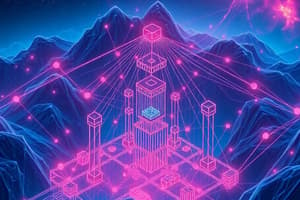Podcast
Questions and Answers
Explain the core characteristic that distinguishes a hierarchical database from other types of database models.
Explain the core characteristic that distinguishes a hierarchical database from other types of database models.
Hierarchical databases organize data in a tree-like structure, where information is stored with parent-child relationships.
What are the main limitations of hierarchical database?
What are the main limitations of hierarchical database?
When a parent node is removed, the child node is removed as well. it only supports one parent per child node
In a hierarchical database, if a parent node representing a 'Department' is removed, what happens to the child nodes representing 'Employees' within that department?
In a hierarchical database, if a parent node representing a 'Department' is removed, what happens to the child nodes representing 'Employees' within that department?
When a parent node is removed, the child node is removed as well.
Describe a scenario where a hierarchical database would be an appropriate choice.
Describe a scenario where a hierarchical database would be an appropriate choice.
How does the network database model overcome a key limitation found in hierarchical databases?
How does the network database model overcome a key limitation found in hierarchical databases?
Explain how a network database can represent relationships that a hierarchical database cannot.
Explain how a network database can represent relationships that a hierarchical database cannot.
Briefly explain why the design or the structure of network model is not user-friendly.
Briefly explain why the design or the structure of network model is not user-friendly.
Give an example of a real-world scenario that is best modeled using a network database, detailing the entities and relationships involved.
Give an example of a real-world scenario that is best modeled using a network database, detailing the entities and relationships involved.
In relational databases, what role do primary and foreign keys play in establishing relationships between tables?
In relational databases, what role do primary and foreign keys play in establishing relationships between tables?
Describe a scenario where using foreign keys in a relational database ensures data integrity.
Describe a scenario where using foreign keys in a relational database ensures data integrity.
Explain how the tabular structure of a relational database supports efficient data retrieval and manipulation.
Explain how the tabular structure of a relational database supports efficient data retrieval and manipulation.
How do object-oriented databases differ from relational databases in how they handle data?
How do object-oriented databases differ from relational databases in how they handle data?
Describe the key benefits of encapsulation in object-oriented databases and how it enhances data management.
Describe the key benefits of encapsulation in object-oriented databases and how it enhances data management.
What are the major characteristics of object oriented database?
What are the major characteristics of object oriented database?
Explain how inheritance in object-oriented databases promotes code reusability and reduces redundancy.
Explain how inheritance in object-oriented databases promotes code reusability and reduces redundancy.
Flashcards
Hierarchical Database
Hierarchical Database
A database model where information is organized in a tree-like structure with multiple nodes.
Hierarchical Data Storage
Hierarchical Data Storage
Hierarchical (top-down or bottom-up) data storage format containing parent and child nodes.
Hierarchical Model Advantage
Hierarchical Model Advantage
Tables are separated from physical storage, simplifying adding or deleting information.
Hierarchical Model limitation
Hierarchical Model limitation
Signup and view all the flashcards
Network Database
Network Database
Signup and view all the flashcards
Network Model Advantage
Network Model Advantage
Signup and view all the flashcards
Network Model Disadvantage
Network Model Disadvantage
Signup and view all the flashcards
Relational Database (RDBMS)
Relational Database (RDBMS)
Signup and view all the flashcards
Primary Key
Primary Key
Signup and view all the flashcards
Linking Tables
Linking Tables
Signup and view all the flashcards
Object Oriented Database
Object Oriented Database
Signup and view all the flashcards
Attributes
Attributes
Signup and view all the flashcards
Methods
Methods
Signup and view all the flashcards
Study Notes
- Databases are categorized based on their usage, structure, and storage methods.
- The main types are hierarchical, network, relational, and object-oriented databases.
Hierarchical Databases
- Organizes information in a tree-like structure with multiple nodes.
- Data is stored in a hierarchical format (top-down or bottom-up).
- In this model, two types of nodes, parent and child, exist on different hierarchical levels.
- Data is stored as records that are interconnected with links.
- Each child record in the tree connects to only one parent, while the parent record can link to several child records.
- Tables are separated from physical storage, simplifying the process of adding or deleting information.
- Most programming languages support reading data from hierarchical databases, enhancing accessibility.
- When a parent node is removed, the child node is also removed.
- Only one parent per child node is supported; complex relationships where a child node needs two parents are not supported by this model.
- Computer file explorers are a real-world example of hierarchical databases.
Network Databases
- Similar to hierarchical databases due to having a hierarchical structure, but there is a major difference
- Child records can link to multiple parent records in a network data model, where as on a hierarchical database they are only linked to one parent
- Network databases are like graph databases, and support multiple relationships instead of adopting a single-parent tree relationship.
- Offers quicker data record access compared to the hierarchical model because data is more interconnected
- Represents multi-parent relationships
- The design or structure isn't user-friendly.
- The network model has the potential to generate system complexity.
Relational Databases (RDBMS)
- Store data in a tabular format with rows and columns.
- Rows represent records, which are collections of related values, each with a unique identification key.
- Columns represent attributes of a specific data type.
- Data is stored in tables with unique data fields that are identifiable through a primary key.
- Tables can be linked using foreign keys.
Object-Oriented Databases
- Stores information in an object-like manner based on object-oriented programming principles.
- Objects contain attributes and methods, making them easy to reference and manipulate.
- Multiple objects are connected using connections.
Studying That Suits You
Use AI to generate personalized quizzes and flashcards to suit your learning preferences.




